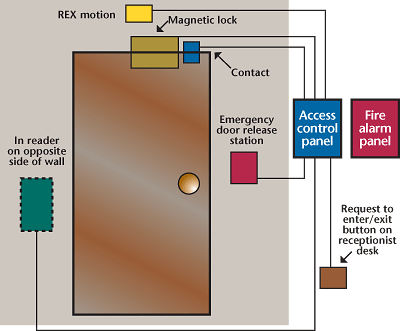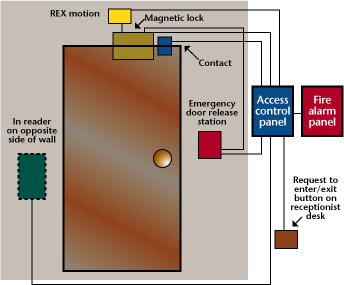
Five-Minute Tech Quiz
1. Shear magnetic locks do not have any moving parts.a. True
b. False
2. Which of the following is a feature of a magnetic lock?
a. Silent operation
b. Fail-safe configuration
c. No moving parts
d. All of the above
e. None of the above
3. An electric strike that requires power to unlock is called:
a. fail-safe.
b. fail-secure.
c. delayed egress.
d. None of the above
4. An electric strike that requires power to lock is called:
a. fail-safe.
b. fail-secure.
c. delayed egress.
d. None of the above
5. Delayed egress “crash†bars are sometimes used on emergency egress doors.
a. True
b. False
6. Electric transfer hinges are typically used for:
a. magnetic shear locks.
b. electric strikes.
c. electric mortise locks.
d. All of the above
e. None of the above
7. Doors can be right- or left-handed.
a. True
b. False
8. If the electric locking device will inhibit emergency egress, you should connect it to the fire alarm system.
a. True
b. False
9. When selecting an electrified locking device, what factors should you consider?
a. Fail-safe or fail-secure
b. Continuous or
intermittent duty
c. Voltage rating
d. Fire and building codes
e. All of the above
10. All keypad-based electric locking mechanisms require external power.
a. True
b. False
11. Which of the following can be used with a keypad for access control?
a. Proximity card
b. Smart card
c. Fingerprint
d. All of the above
12. All self-contained keypads allow only one user code.
a. True
b. False
13. MOVs are used to protect an electric lock from RFI.
a. True
b. False
14. When easy egress door hardware is installed, you never need to use a REX device.
a. True
b. False
15. Which of the following electric lock types would most commonly be installed on a frameless glass door?
a. Electric strike
b. Electric mortise lock
c. Magnetic lock
d. Any of the above
What’s Wrong with This?
Wally `Larman installed an access control system that included a magnetic lock on the main entry/exit door. He installed the devices as shown in this diagram, connecting a manual pull station as a REX device to release the magnetic lock in the event of an emergency. He tested the system and everything worked as planned, but when the building inspector arrived, he was not satisfied. Can you see what Wally did wrong and what he must do to correct the problem?Answers
1. b2. d
3. b
4. a – They are called fail-safe because when power is removed or in a power failure, the lock will release automatically.
5. a – These devices will open the door if held for a set period of time. It is important that you check with the local AHJ before installing these devices to make sure that they are acceptable.
6. c
7. a
8. a – In addition, you should check all applicable codes to make sure that you select the correct lock and connect it so that it will meet all code requirements for emergency egress.
9. e
10. b – There is a wide variety of self-contained keypad locking devices that use internal, replaceable batteries for power.
11. d – Keypads are available with any of these readers as a single unit. Some may be programmed to always require both PIN and credential or allow access or grant access with only a correct PIN entry.
12. b – Many self-contained keypads can accommodate multiple user codes and even time zones. Additionally, some may be networked, allowing data to be gathered at a single point.
13. b – MOVs are used to protect the access controller from back EMF generated by the coil in the electric lock.
14. b – A REX motion device may be used to shunt the door status switch automatically when someone approaches the door to exit. If you do not install some type of REX device on a door with easy egress door hardware and a monitored door status switch, a door-forced alarm event could be generated whenever someone leaves.
d. c

Answer to: What’s Wrong with This?
Wally’s problem is caused by the method that he used to release the door in an emergency. Since the REX motion and emergency door release station are only connected to the access control panel, they will only work if the access controller is functioning. If the controller fails, the door could remain secure, thereby preventing egress.Wally should rewire the system as shown in this diagram, connecting the REX motion and emergency door release station directly to the lock to interrupt power and to the access controller. In this way, power will be cut to the lock, immediately releasing the door regardless of the operating condition of the access controller and generating a request to exit to the controller. Additionally, the access control system should be connected to the fire alarm system so that in the event of a fire alarm, all doors will be automatically released. It is important whenever you install electric locking devices on exit doors that you carefully follow all applicable codes and check with the local AHJ to determine what their requirements for emergency exit devices are.


